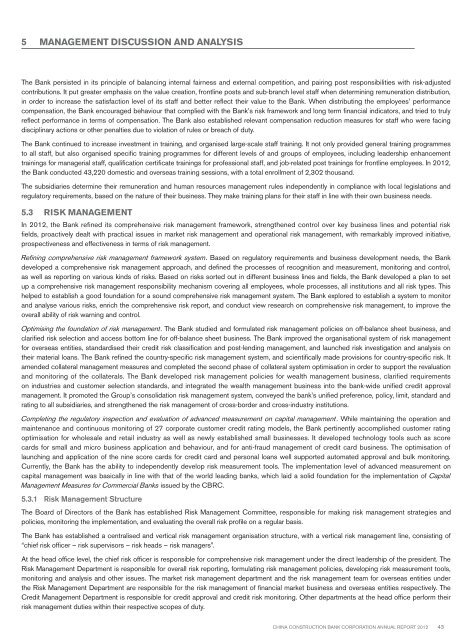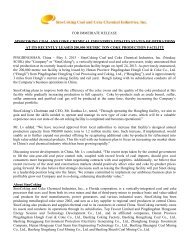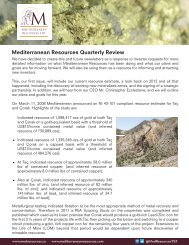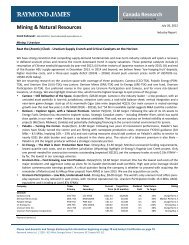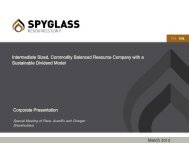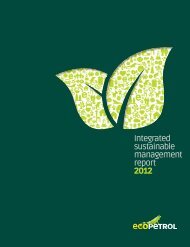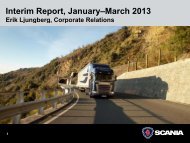Annual Report 2012
Annual Report 2012
Annual Report 2012
- No tags were found...
Create successful ePaper yourself
Turn your PDF publications into a flip-book with our unique Google optimized e-Paper software.
5 MANAGEMENT DISCUSSION AND ANALYSISThe Bank persisted in its principle of balancing internal fairness and external competition, and pairing post responsibilities with risk-adjustedcontributions. It put greater emphasis on the value creation, frontline posts and sub-branch level staff when determining remuneration distribution,in order to increase the satisfaction level of its staff and better reflect their value to the Bank. When distributing the employees’ performancecompensation, the Bank encouraged behaviour that complied with the Bank’s risk framework and long term financial indicators, and tried to trulyreflect performance in terms of compensation. The Bank also established relevant compensation reduction measures for staff who were facingdisciplinary actions or other penalties due to violation of rules or breach of duty.The Bank continued to increase investment in training, and organised large-scale staff training. It not only provided general training programmesto all staff, but also organised specific training programmes for different levels of and groups of employees, including leadership enhancementtrainings for managerial staff, qualification certificate trainings for professional staff, and job-related post trainings for frontline employees. In <strong>2012</strong>,the Bank conducted 43,220 domestic and overseas training sessions, with a total enrollment of 2,302 thousand.The subsidiaries determine their remuneration and human resources management rules independently in compliance with local legislations andregulatory requirements, based on the nature of their business. They make training plans for their staff in line with their own business needs.5.3 RISK MANAGEMENTIn <strong>2012</strong>, the Bank refined its comprehensive risk management framework, strengthened control over key business lines and potential riskfields, proactively dealt with practical issues in market risk management and operational risk management, with remarkably improved initiative,prospectiveness and effectiveness in terms of risk management.Refining comprehensive risk management framework system. Based on regulatory requirements and business development needs, the Bankdeveloped a comprehensive risk management approach, and defined the processes of recognition and measurement, monitoring and control,as well as reporting on various kinds of risks. Based on risks sorted out in different business lines and fields, the Bank developed a plan to setup a comprehensive risk management responsibility mechanism covering all employees, whole processes, all institutions and all risk types. Thishelped to establish a good foundation for a sound comprehensive risk management system. The Bank explored to establish a system to monitorand analyse various risks, enrich the comprehensive risk report, and conduct view research on comprehensive risk management, to improve theoverall ability of risk warning and control.Optimising the foundation of risk management. The Bank studied and formulated risk management policies on off-balance sheet business, andclarified risk selection and access bottom line for off-balance sheet business. The Bank improved the organisational system of risk managementfor overseas entities, standardised their credit risk classification and post-lending management, and launched risk investigation and analysis ontheir material loans. The Bank refined the country-specific risk management system, and scientifically made provisions for country-specific risk. Itamended collateral management measures and completed the second phase of collateral system optimisation in order to support the revaluationand monitoring of the collaterals. The Bank developed risk management policies for wealth management business, clarified requirementson industries and customer selection standards, and integrated the wealth management business into the bank-wide unified credit approvalmanagement. It promoted the Group’s consolidation risk management system, conveyed the bank’s unified preference, policy, limit, standard andrating to all subsidiaries, and strengthened the risk management of cross-border and cross-industry institutions.Completing the regulatory inspection and evaluation of advanced measurement on capital management . While maintaining the operation andmaintenance and continuous monitoring of 27 corporate customer credit rating models, the Bank pertinently accomplished customer ratingoptimisation for wholesale and retail industry as well as newly established small businesses. It developed technology tools such as scorecards for small and micro business application and behaviour, and for anti-fraud management of credit card business. The optimisation oflaunching and application of the nine score cards for credit card and personal loans well supported automated approval and bulk monitoring.Currently, the Bank has the ability to independently develop risk measurement tools. The implementation level of advanced measurement oncapital management was basically in line with that of the world leading banks, which laid a solid foundation for the implementation of CapitalManagement Measures for Commercial Banks issued by the CBRC.5.3.1 Risk Management StructureThe Board of Directors of the Bank has established Risk Management Committee, responsible for making risk management strategies andpolicies, monitoring the implementation, and evaluating the overall risk profile on a regular basis.The Bank has established a centralised and vertical risk management organisation structure, with a vertical risk management line, consisting of“chief risk officer – risk supervisors – risk heads – risk managers”.At the head office level, the chief risk officer is responsible for comprehensive risk management under the direct leadership of the president. TheRisk Management Department is responsible for overall risk reporting, formulating risk management policies, developing risk measurement tools,monitoring and analysis and other issues. The market risk management department and the risk management team for overseas entities underthe Risk Management Department are responsible for the risk management of financial market business and overseas entities respectively. TheCredit Management Department is responsible for credit approval and credit risk monitoring. Other departments at the head office perform theirrisk management duties within their respective scopes of duty.China Construction Bank Corporation annual report <strong>2012</strong>43


